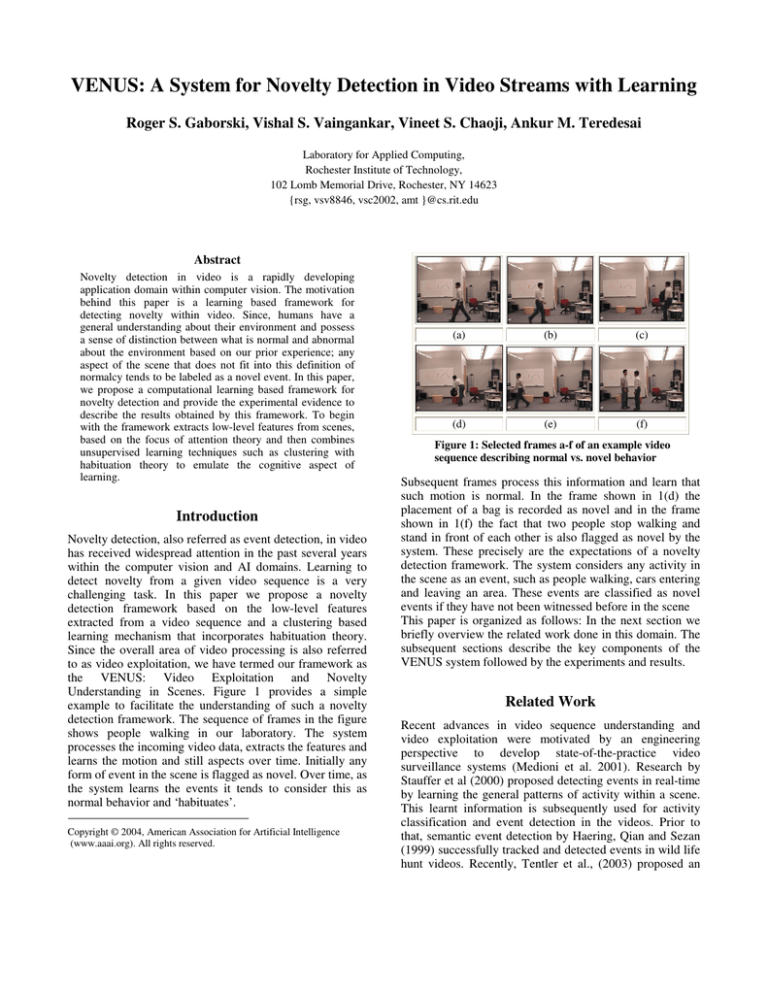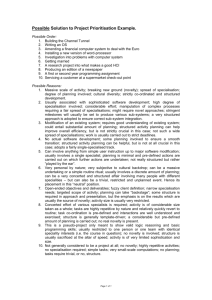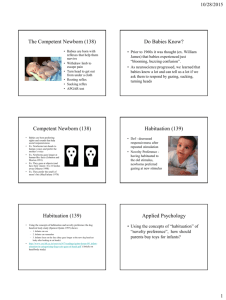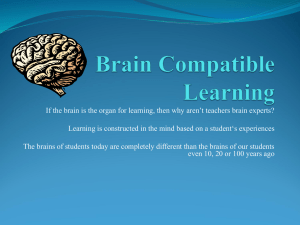
VENUS: A System for Novelty Detection in Video Streams with Learning
Roger S. Gaborski, Vishal S. Vaingankar, Vineet S. Chaoji, Ankur M. Teredesai
Laboratory for Applied Computing,
Rochester Institute of Technology,
102 Lomb Memorial Drive, Rochester, NY 14623
{rsg, vsv8846, vsc2002, amt }@cs.rit.edu
Abstract
Novelty detection in video is a rapidly developing
application domain within computer vision. The motivation
behind this paper is a learning based framework for
detecting novelty within video. Since, humans have a
general understanding about their environment and possess
a sense of distinction between what is normal and abnormal
about the environment based on our prior experience; any
aspect of the scene that does not fit into this definition of
normalcy tends to be labeled as a novel event. In this paper,
we propose a computational learning based framework for
novelty detection and provide the experimental evidence to
describe the results obtained by this framework. To begin
with the framework extracts low-level features from scenes,
based on the focus of attention theory and then combines
unsupervised learning techniques such as clustering with
habituation theory to emulate the cognitive aspect of
learning.
Introduction
Novelty detection, also referred as event detection, in video
has received widespread attention in the past several years
within the computer vision and AI domains. Learning to
detect novelty from a given video sequence is a very
challenging task. In this paper we propose a novelty
detection framework based on the low-level features
extracted from a video sequence and a clustering based
learning mechanism that incorporates habituation theory.
Since the overall area of video processing is also referred
to as video exploitation, we have termed our framework as
the VENUS: Video Exploitation and Novelty
Understanding in Scenes. Figure 1 provides a simple
example to facilitate the understanding of such a novelty
detection framework. The sequence of frames in the figure
shows people walking in our laboratory. The system
processes the incoming video data, extracts the features and
learns the motion and still aspects over time. Initially any
form of event in the scene is flagged as novel. Over time, as
the system learns the events it tends to consider this as
normal behavior and ‘habituates’.
Copyright © 2004, American Association for Artificial Intelligence
(www.aaai.org). All rights reserved.
(a)
(b)
(c)
(d)
(e)
(f)
Figure 1: Selected frames a-f of an example video
sequence describing normal vs. novel behavior
Subsequent frames process this information and learn that
such motion is normal. In the frame shown in 1(d) the
placement of a bag is recorded as novel and in the frame
shown in 1(f) the fact that two people stop walking and
stand in front of each other is also flagged as novel by the
system. These precisely are the expectations of a novelty
detection framework. The system considers any activity in
the scene as an event, such as people walking, cars entering
and leaving an area. These events are classified as novel
events if they have not been witnessed before in the scene
This paper is organized as follows: In the next section we
briefly overview the related work done in this domain. The
subsequent sections describe the key components of the
VENUS system followed by the experiments and results.
Related Work
Recent advances in video sequence understanding and
video exploitation were motivated by an engineering
perspective to develop state-of-the-practice video
surveillance systems (Medioni et al. 2001). Research by
Stauffer et al (2000) proposed detecting events in real-time
by learning the general patterns of activity within a scene.
This learnt information is subsequently used for activity
classification and event detection in the videos. Prior to
that, semantic event detection by Haering, Qian and Sezan
(1999) successfully tracked and detected events in wild life
hunt videos. Recently, Tentler et al., (2003) proposed an
event detection framework based on the use of low-level
features. The proposed VENUS framework uses the lowlevel features obtained from the focus of attention theory
and combines it with habituation based clustering.
Habituation is an effect by which a system ceases to
respond after repeated presentations of the same stimulus
(Siddle, Kuiack and Kroese 1983). Computational
modeling of habituation has been applied in mobile robots
by Marsland, Nehmzow and Shapiro (1999). Their work
models habituation as an exponential function that lends to
describing the short-term and long-term memory aspects of
learning. In a related previous work we described the
primitives of the learning aspect as inspired by biological
theories such as habituation (Vaingankar et al. 2003).
Initial experimental results on the video sequence described
in Figure 1 are discussed in (Gaborski et al. 2004).
Final
novelty map
Still learning &
novelty detection
module
Directional
motion maps
Color
maps
Orientation
maps
2D Spatial filtering
The event detection model described in this paper consists
of two major components. First, a focus of attention
component that generates the low level features - intensity
contrast, color, orientation and directional motion. Second,
a learning component that handles novelty detection. The
following sub-sections describe the system components.
Video
sequence
Figure 2 shows the block diagram of VENUS’ novelty
detection framework. The first part of our framework is the
focus of attention system. The motivation for using the
focus of attention theory is provided by Koch and Ullman
(1985). Given the enormous amount of visual information
available in a scene, we, as humans, process only a subset
of it. We tend to focus on the interesting aspects of the
scene ignoring the uninteresting ones. The attention system
in our framework is based on the selective attention theory
initially modeled by Itti and Koch (2001), where a saliency
map topographically represents the object’s saliency with
respect to its surrounding. Attention allows us to focus on
the relevant regions in the scene and thus reduces the
amount of information needed for further processing as
verified in Gaborski, Vaingankar and Canosa (2003).
Objects that are highly salient in the scene are further
tracked for possible novel events. The video sequences are
processed in the still and motion saliency channels. The
still saliency channel processes every frame individually
and generates topographical saliency maps. Consider an
airport scene where someone leaves an object in a
restricted area and walks away. The still saliency channel
detects this object as a salient item. Since this object was
not part of the original scene, the introduction of the object
fires a novel event, which is a feature of the still learning &
novelty detection module. The motion saliency channel
detects the salient moving objects of the scene, in this case
the motion of the person who brought the object.
Still Processing: The still saliency channel processes every
frame of the video sequence and extracts the low-level
Motion learning &
novelty detection
module
Motion attention
module
Still attention
module
VENUS’ System Framework
Focus of attention
+
Intensity
maps
3D Spatiotemporal
filtering
Figure 2: The VENUS’ Novelty Detection Framework
features. The information from the video frames is
extracted using multi-resolution orientation, color, and
intensity contrast filters. This form of processing is called
the bottom-up focus of attention (Itti and Koch 2001), since
objects evoke attention based on the low-level feature
conspicuity.
The 2D multiresolution spatial filters are convolved with
the input image to obtain the topographical feature maps.
Intensity contrast is extracted using difference of Gaussian
filters. The intensity contrast filtering simulates the
function of the retinal ganglion cells which posses the
centre-surround mechanism. The color information is
extracted using the color opponent filters.
The orientation processing employs Gabor orientation
filters to extracts edges of 0o, 45o, 90o, and 135o orientations.
The sine and cosine Gabor filters oriented in the spatial
axis is modeled based on the receptive field properties of
the orientation tuned simple cells of the early visual cortex.
Due to the centre surround antagonistic nature of the
feature extraction filters, the topographical maps obtained
are called the saliency maps. The still attention module
combines the multi-resolution feature saliency maps within
the respective feature channels to form the final orientation,
color, and intensity contrast feature saliency maps which
are inputs to the still learning & novelty detection module.
Motion Processing: Motion detection in our system is
achieved by using the 3D Gaussian derivative
spatiotemporal filters tuned to respond to moving stimuli
(Young, Lesperance and Meyer 2001). This method of
motion filtering is similar to quadrature sine and cosine
pair spatiotemporal energy filters developed by Adelson
and Bergen (1985). The first step in the motion detection
process is convolving the multi-resolution intensity
saliency maps with a 3D band-pass spatiotemporal filter.
This filter gives optimal response to regions of motion in
the scene irrespective of the direction of motion.
Theoretically, such a filter would give the maximum
response after an object which was not there before, now
appears. The result of the above convolution is bounded
(by a threshold) to produce a mask for the motion in an
image. In order to extract directional motion, the multiresolution intensity saliency maps are then convolved with
a set of four direction-selective spatiotemporal filters. The
direction selective filters are similar to the band-pass filters
except that the directional filters are oriented in both spacetime (x,t) axes. The orientation of the Gaussian derivative
lobes in the (x, t) axis determines the direction to which the
filter is tuned. Suppose an (x,t) orientation of 45 degree
detects right moving objects, then an (x,t) orientation of
135 degree would be tuned to detecting left moving
objects. The result of this directional filtering is a set of
multi-resolution directional motion maps (up, down, right,
left). The degree of space-time orientation tunes the filters
to varying speeds of moving objects. The previously
obtained motion mask is then applied to the directional
motion maps, to mask out any spurious response generated
for stationary objects. The motion attention module
combines the multi-resolution direction maps within each
direction channel to give final four directional motion
saliency maps. The still saliency and the motion saliency
maps are the input into the novelty detection modules. The
saliency maps as input to the learning & novelty detection
modules causes only the salient regions of the scene to be
tracked for potential novel events.
Novelty Detection using Learning
The novelty detection framework in VENUS has two
components – “still learning & novelty detection module”
and “motion learning & novelty detection module”. The
still learning & novelty detection module in this system is
based on Tentler et. al.(2003). Still aspects of the scenes
are learned based on simple topographical averaging of
feature values in the still feature saliency maps. This
averaged map is called the still habituation map which is
representative of changes to non-motion aspects of the
scene over time. The still novelty is calculated by taking a
difference between the current frame’s still saliency map
and the still habituation map. An event can be novel by
virtue of any of its low-level features or a combination of
them.
On presentation of a never-seen-before motion feature
value, the ‘Motion learning & novelty detection module’
classifies it as being novel. If the same feature value is
observed repeatedly over time, the system habituates to it
and stops flagging it as a novel event. On the contrary, lack
of additional occurrences of the same event causes the
system to recover its original sensitivity for the feature, i.e.
the habituation effect decreases. This concept is based on
Kohonen’s theory (1988) of novelty detection filters with a
forgetting effect. The theory states that the system can only
memorize patterns when it is frequently exposed to them.
The memorized pattern tends to be forgotten if it is not
reinforced repeatedly over time. The forgetting term is
similar to the dis-habituation effect described by Wang
(1995).
Novelty detection in this system is region based where a
region is an 8-by-8 pixel area on a frame of the video. A
new event in any region is captured by the creation of a
cluster in that region. An event can be intuitively
considered to be any activity depicted in the motion maps.
Each region has a pool of clusters that represent unique
events observed by the system in that region. A new cluster
formed is compared with clusters in the pool to see if it can
be merged with any of them. Merging of clusters indicates
occurrence of an event that is similar to a previously learnt
event. The clustering algorithm treats the data as a
Gaussian mixture. Each cluster obtained represents a
Gaussian in the mixture. Novelty detection is thus reduced
to identifying novel clusters in every region. The algorithm
does not limit the number of clusters per region since the
number of novel event cannot be predicted ahead of time.
Each cluster follows a sigmoidal-like habituation curve
(Vaingankar et al. 2003) to model learning. As per
habituation theory, an event is not instantaneously learnt. It
takes some number of occurrences before a system gets
completely habituated. Novelty is inversely related to the
degree of habituation the cluster has attained. Higher the
habituation value, the lower is its features’ novelty and vice
versa. The novel events gathered from each motion
direction map are combined with still novelty map to form
a final novelty map.
Experiments and Results
Analysis 1:
The goal of the experiments was to quantify the amount of
novelty and analyze the effect of the habituation model on
learning. We define a novelty index which ranges from
zero to one. The novelty index measures the amount of
novelty as compared to the motion activity in the scene and
is computed as the ratio of the number of novel regions to
the number of motion activity regions in a frame. This ratio
is calculated for every frame of the video. Higher the ratio,
greater is the novelty in the frame. We also define degree
of habituation as an index which describes how well a
region has learnt a particular event. The experiments are
conducted for two scenes. Scene ‘A’ shows a sequence of
two people (P1 and P2) walking from right to left one after
the other. Here, P1 and P2 walking are independent events
which together form a single sequence. This sequence is
repeated thrice without any delay between the sequences.
The objective of this setup is to gauge the learning
capability of the system to repeated occurrences of people
walking in the scene. In scene ‘B’, the same scene is used
but with considerable time delay (frames 130 to 440)
between the second and third sequence. The objective for
setting up this scenario is to test whether the system forgets
a previously learnt event. Figure 3 and 4 show the
variations in the novelty index over the complete video, for
Cut-off threshold
P1
P2
Sequence 1
P1
P2
Sequence 2
P1
P2
Sequence 3
Figure 5: Habituation curve for one cluster observed within a
8X8 region (Scene A).
Figure 3: Novelty Index for Scene A
Cut-off threshold
Figure 6: Habituation curve for one cluster observed within a
8X8 region (Scene B).
P1 P2 P1
P2
P1
P2
Figure 4: Novelty Index for Scene B
the two scenes respectively. It can be observed in figure 3
for sequence 1 (frames 1 to 60), that the novelty index for
event P2 is lower than that of P1 indicating that the system
is getting habituated to the event. On the second sequence
(P1, P2 frames 60 to130), the novelty index drops to zero.
This effect is observed since the regions in the scene have
already learnt the motion sequence that occurred in
sequence 1. The system continues to invoke zero novelty
(novelty index zero) for sequence 3 (frames 130 to 190).
Thus with regular reinforcement of similar motion values
the clusters do not fire novelty.
Figure 4, shows the corresponding results for scene B. The
delay between sequence 2 and 3 causes the system to
completely forget the events which were learnt previously.
This can be observed by the sudden rise in novelty index
for event P1 in sequence 3. Again the system starts to learn
this novel event which is visible in the reduced novelty
index of the following P2.
Graphs in figures 5 and 6 illustrate the habituation curve
for a cluster in a particular region over all the frames in the
scene. The y axis shows the degree to which the cluster is
habituated to that particular event.
Figure 5 shows the habituation curve for scene A. On
seeing the event P1, a cluster is created for that region and
an initial habituation value of 1 is assigned. Overtime the
habituation value decays at a pre-assigned decay rate. This
is seen in the smooth drop in the degree of habituation for
the cluster. At frame 40, when the same region is activated
by event P2, the cluster recovers from the drop in
habituation. This is seen in sudden upward spike in the
curve. Similar behavior is observed for the remaining
events. As seen from the graph the cluster never reaches the
cut-off threshold, indicating that the cluster was regularly
reinforced, thereby retaining the event for a longer
duration. After the cluster is reinforced with a repeated
event, the decay rate is updated such that the system forgets
the event at a slower rate. The decreasing slope of the
habituation curve after each recovery confirms this effect.
Figure 6 shows the corresponding habituation curve for
scene B. During the delay after sequence 2, the habituation
value reaches the cut-off threshold. This threshold
symbolizes the loss of this event from the system’s
memory. On frame 450 the event P1 reoccurs. Since the
Frame #
25
Car entering the
parking lot.
Image from video
Motion mask
Motion Novelty mask
Analysis
Car seen for the
first time and was
detected by the
novelty mask
133
Person walking
down the
pathway.
The person
walking briskly is
detected by the
novelty mask.
200
Person walking
down the
pathway.
The system still
considers this
novel since it is
not completely
habituated yet.
364
People walking
and car leaving
the parking lot.
Moving trees stop
firing novelty as
their swaying
motion is learnt.
628
People walking
on the already
habituated
pathway.
People walking
are not detected
as novel events.
723
People and cars
on the learnt
regions of the
scene.
People and car
are not detected
as novel events.
957
People walking
on the lawn
Novelty detected
since this is first
instance of people
walking on the
lawn
1248
People back on
the pathway.
People not
detected as novel
since the pathway
is already
habituated to
motion
Figure 7: Images from video, Motion Mask and the Motion Novelty mask
system has already forgotten this event, it fires a novelty for
it and again assigns an initial habituation value.
Analysis 2: The system successfully detects and tracks
regional events. Figure 7 shows scenes of videos recorded
on a university campus. This video sequence shows people
walking on the pathway and cars entering and leaving the
parking lot. The figure shows the actual image, the motion
mask and the motion novelty mask during various frames
of the video. Moving objects in the frame are shown within
bounded box in the motion mask. The regions within the
motion mask that depict a novel event are shown in the
novelty mask. Initially the system fires novelty for each
motion activity (event) until it learns the motion in the
regions. Consider the example of motion detected for the
swaying trees. Initially the system considers this tree
motion as novel but gradually habituates to it and no more
shows it as a novel event. This can be seen in novelty mask
of frames 25, 133, 200 that detects the tree motion as
novel, but in frames 364 and further the tree regions do not
show a novel event. The system has been successfully
tested on outdoor as well as indoor video scenes.
Future Work and Discussion
In the current framework we do not make use of any high
level object descriptors. This can be one of the avenues to
explore in future for content analysis. In this paper we
described a system for novelty detection on natural scenes.
We termed this system as VENUS. The central
contribution of this work was to combine the recent
advances in Computer Vision (saliency and focus of
attention) with Data Mining (mining high speed data
streams). The described system successfully employs the
theory of habituation for learning novel events over time in
a video data stream. We did not place any constraints or
assumptions on the type of video data our system can
process. As long as low-level features can be extracted and
motion maps can be generated to capture motion, the
system’s learning component will detect the novel events.
This combination, of the focus of attention theory with
habituation theory; is the real strength of the VENUS
system.
References
Adelson, E.H.; and Bergen, J.R. 1985. Spatiotemporal
energy models for the perception of motion. Journal of
Optical Society of America. 2:284-321.
Gaborski, R.; Vaingankar V.S.; and Canosa, R.L. 2003.
Goal Directed Visual Search Based on Color Cues: Cooperative Effects of Top-down & Bottom-up Visual
Attention. In Proceedings of ANNIE. Rolla, Missouri.
Gaborski R. S., Vaingankar V. S., Teredesai A., Chaoji V.,
Tentler A. 2004. Detection of inconsistent regions in video
streams. IS&T/SPIE Electronic Imaging: Human Vision
and Electronic Imaging IX, San Jose.
Haering, N. C., Qian, R.J., and Sezan, M. I. 1999. A
Semantic Event Detection Approach and Its Application to
Detecting Hunts in Wildlife Video. In IEEE Transactions
on Circuits and Systems for Video technology, 10:857—
868.
Itti L., and C. Koch. 2001. Computational modeling of
visual attention. Nature Neuroscience Review., 2(3):194203.
Koch, C., and S. Ullman. 1985. Shifts in selective visual
attention: towards the underlying neural circuitry. Human
Neurobiology. 4:219-227.
Kohonen, T. eds. 1988. Self-Organization and Associative
Memory. New York: Springer-Verlag.
Marsland, S.; Nehmzow, U.; and Shapiro, J. 1999. A model
of habituation applied to mobile robots. In Proceedings of
Towards Intelligent Mobile Robots. Bristol, UK.
Medioni,G.; Cohen, I.; Brmond, F.; Hongeng, S.; and
Nevatia R. 2001. Event Detection and Analysis from Video
Streams. IEEE Transactions on Pattern Analysis and
Machine Intelligence, 23: 8, 873-889.
Siddle, D. A. T.; Kuiack, M.; and Kroese, S. B. 1983. The
Orienting reflex. (pp. 149-170). In Physiological
Correlates of Human Behaviour. Edited by Gale A. and
Edwards, J. Academic Press: London.
Stauffer, C.; and Grimson, E. 2000. Learning Patterns of
Activity Using Real-Time Tracking. In IEEE Transactions
on Pattern Analysis and Machine Intelligence. 22(8):747757.
Tentler A.; Vaingankar V.; Gaborski R.; and Teredesai A.
2003. Event Detection in Video Sequences of Natural
Scenes. In IEEE Western New York Image Processing
Workshop, Rochester, New York.
Vaingankar V.S, Chaoji V, Gaborski R S, Teredesai A M.
2003. "Cognitively motivated habituation for novelty
detection in video", NIPS Workshop on Open Challenges
in Cognitive Vision. Whistler, Canada.
Wang D.L. 1995. Habituation. Arbib M.A. (ed.), The
Handbook of Brain Theory and Neural Networks. 441-444,
MIT Press.
Young, R. A; Lesperance, R. M., and Meyer, W. W. 2001
The Gaussian Derivative model for spatialtemporal vision:
I. Cortical Model. Spatial Vision, 14(3,4):261-319.







